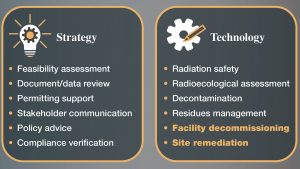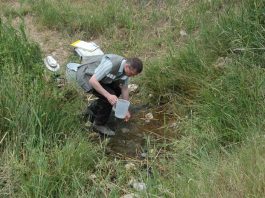Dr Hagen Gunther Jung, Director of GeoEnergy Consult, discusses the decommissioning and remediation of mining and processing affected by Naturally Occurring Radioactive Material (NORM).
When decommissioning and remediation of former mining and processing operations involve radioactive material – like from rare earths or any other NORM-affected commodity – particular safety provisions are required to prevent any hazard from arising.
Closure of mining and processing operations
Proper closure of NORM-affected mining or processing operations, allowing for the mitigation of associated risks, possibly even site re-use and minimisation of costly aftercare, prevents from the generation of radioactive legacies.
For projects striving to get permitted (or for running operations), it may appear irritating to already consider future closure. However, having a preliminary closure plan, which demonstrates the later ability to safely decommission those facilities and to remediate potentially contaminated sites, can be required by regulators for issuing (or prolonging) operational permits. Moreover, a preliminary closure plan provides first information about the necessary financial provisions.
If production at mines, mills or refineries ceases, the challenge arises to re-establish the conditions of pre-production time as far as possible/reasonable. While site rehabilitation, also called reclamation or recultivation (i.e. earthworks, landscaping, etc.), is a usual approach for conventional mines too, remediation involves the clean-up of a site which was accidentally contaminated: normally by removal of radionuclides. Hence, decommissioning of facilities and remediation of those sites has many aspects: technical, health, environmental, economic, stakeholder, social, political, legal, etc.

Radiological screening of mining sites
In terms of the technical fundament, the first step is a radiological screening survey both of facilities and the site. The screening can be complemented by assessment of the operational history and selected environmental monitoring data to identify potentially suspicious areas. If the screening results are below defined limit values, no further specific action is required than conventional dismantling and rehabilitation. In addition, preparation for long-term safety of surficial tailings impoundments can require specific measures.
However, should the screening reveal increased contamination levels, a detailed survey needs to be conducted to determine their spatial height. If indicated, numerical modeling supports the assessment of the resulting risk. While intervention levels derive also from international standards, radiological clean-up criteria/end-state definitions are usually based on national regulations. Only in exceptional cases, should complete removal of contamination be hardly possible, it can be acceptable to define those criteria specifically, i.e. based on assessment of the locally prevailing risk.
Removal of radioactive contamination
Safe removal of radioactive contamination for decommissioning of equipment and facilities applies technologies, which range from manual/mechanical preparation over abrasive treatment to more complex processes like (electro-) chemical decontamination. For remediation of radioactively contaminated sites, in particular for cleaning of environmental media like soil or groundwater, similar or adapted technologies are in use as for remediation of conventionally contaminated sites: e.g. soilwater extraction, soil washing/separation and active or passive treatment of groundwater and seepage.
If complete removal of radioactive contamination can be verified (by adequate repetition of the radiological survey), spent equipment is fragmented and facilities are conventionally dismantled. The site is prepared for conventional rehabilitation. Thus, apart from arising conventional waste, decommissioning and remediation generate radioactive NORM waste, which needs to be managed (treated/back-filled/disposed off in landfills, etc.).
Finally, the site is released from regulatory control. In particular cases, regulators may require a post-closure environmental monitoring programme to ensure the continuing success of decommissioning and remediation during an institutional control period.
Please note, this article will also appear in the twelfth edition of our quarterly publication.









